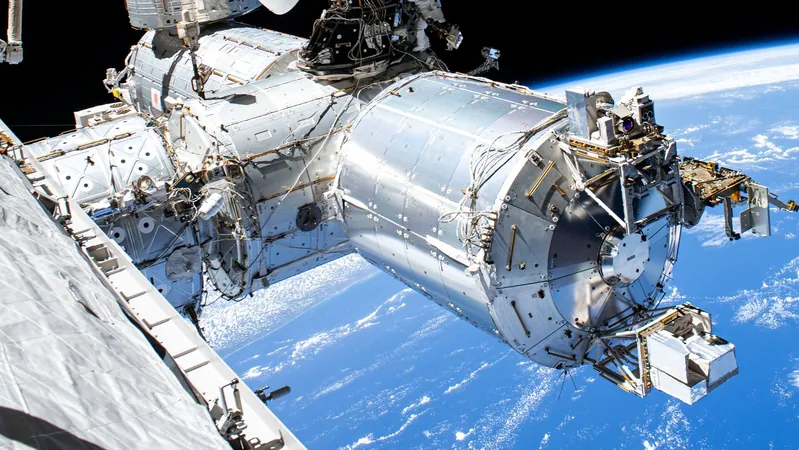
Columbus Laboratory Makes History: 100,000 Orbits and Counting!
2025-09-12
Author: Mei
A Milestone in Space Exploration
On December 9, 2025, the Columbus laboratory aboard the International Space Station (ISS) celebrated a monumental achievement—its 100,000th orbit around Earth! This significant milestone highlights Europe's impressive contributions to science and exploration in space.
A Hub of Innovation Since 2008
Launched in 2008, the Columbus module has served as a vibrant hub for research and innovation. Orbiting Earth at a staggering speed of 28,800 kilometers per hour, it hovers about 400 kilometers above our planet. In its remarkable journey spanning 6,427 days, Columbus has traveled over 4.26 billion kilometers and welcomed astronauts from more than 20 nations, facilitating hundreds of invaluable experiments focused on human health, material science, and beyond.
Engineering Marvel of Europe
Designed and constructed by Airbus, Columbus stands as a testament to European engineering prowess. This complex module, with thousands of integrated parts, required seamless coordination across multiple disciplines and countries, marking a significant advancement in European space collaboration. Built to endure the extreme conditions of space, Columbus can withstand temperatures ranging from a scorching +120°C in sunlight to a chilling -150°C in shadow, all while fending off radiation and micrometeoroid impacts.
Mini-Laboratories in Space
Inside its 7-meter-long and 4.5-meter-wide structure, Columbus boasts 10 dedicated experiment racks, each functioning as a mini-laboratory. Scientists utilize these facilities to conduct groundbreaking research in microgravity—an environment where unique phenomena emerge that simply cannot be replicated on Earth.
Cutting-Edge Research with Real-World Applications
Columbus has been the launchpad for over 250 experiments, with more on the horizon. Currently, 21 of these experiments are active—13 from the European Space Agency (ESA) and eight from NASA. During the ongoing Increment 73 mission phase, over 50 experiments have either been planned or executed, ranging from cold plasma studies to investigations on bone density and cognitive functions. Most of these experiments are a blend of automated and crew-operated procedures, with teams working diligently around the clock to ensure success.
A Source of Inspiration
Beyond scientific research, Columbus also plays a pivotal role in education, with initiatives such as AstroPi enabling over 163,000 students to write and run their own code aboard the ISS. This inspiration fuels the next generation of scientists and engineers.
24/7 Operations from Earth
Operations are meticulously managed by dedicated teams at the Columbus Control Centre near Munich, Germany, who have clocked over 19,000 shifts since Columbus's installation. Their work ensures the module remains safe, efficient, and scientifically productive, diligently coordinating everything from system checks to astronaut support.
A Symbol of European Space Excellence
Throughout its journey, 16 ESA astronauts and numerous international counterparts including those from the United States, Canada, and Japan have worked within Columbus. Some even utilized the module as a temporary living space in the CASA crew quarters. As Columbus marks this historic 100,000-orbit milestone, it embodies European excellence in space—serving not just as a module but as a laboratory, a classroom, and a collaborative platform that has inspired groundbreaking technologies, including contributions to the Orion European Service Module and humanity's upcoming lunar missions under the Artemis program.
Join the Celebration!
Dive deeper into the extraordinary world of the Columbus laboratory with our Q&A feature, packed with fascinating facts and behind-the-scenes insights into Europe’s scientific marvel orbiting our planet.


 Brasil (PT)
Brasil (PT)
 Canada (EN)
Canada (EN)
 Chile (ES)
Chile (ES)
 Česko (CS)
Česko (CS)
 대한민국 (KO)
대한민국 (KO)
 España (ES)
España (ES)
 France (FR)
France (FR)
 Hong Kong (EN)
Hong Kong (EN)
 Italia (IT)
Italia (IT)
 日本 (JA)
日本 (JA)
 Magyarország (HU)
Magyarország (HU)
 Norge (NO)
Norge (NO)
 Polska (PL)
Polska (PL)
 Schweiz (DE)
Schweiz (DE)
 Singapore (EN)
Singapore (EN)
 Sverige (SV)
Sverige (SV)
 Suomi (FI)
Suomi (FI)
 Türkiye (TR)
Türkiye (TR)
 الإمارات العربية المتحدة (AR)
الإمارات العربية المتحدة (AR)